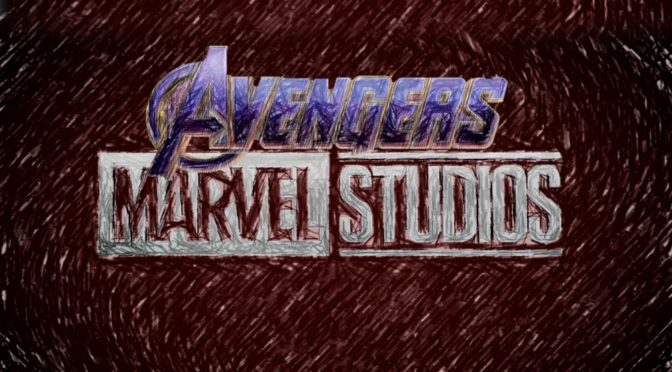This year saw the end of an era. AVENGERS: ENDGAME is not only one of the bestselling films of all time, it is also the culmination of the ‘Infinity Saga’, twenty-two films all focusing on one or more Marvel superhero character, from IRON MAN (2008) to CAPTAIN MARVEL (2019).
The most recent solo film is notable as the only one of the twenty-two films to have a female character as its main focus in Carol Danvers; the only other contender is ANT-MAN AND THE WASP (2018), which has a male and a female lead. BLACK PANTHER (2018), meanwhile, is the only film in the series to have a black superhero as its main protagonist.
The AVENGERS quartet best demonstrates the franchise’s evolution, and by looking at the four films’ respective posters, we can observe the increasing diversity of the casts, beginning with THE AVENGERS (2012).
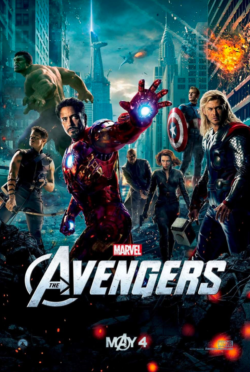
Of the seven heroes depicted in the uncrowded poster, only one is female (Scarlet Johansson’s Black Widow) and only one is black (Samuel L. Jackson’s Nick Fury). These two characters, along with Jeremy Renner’s Hawkeye, don’t have their own standalone films in the Infinity Saga, unlike Captain America (Chris Evans), the Hulk (Mark Ruffalo), Iron Man (Robert Downey Jr.) and Thor (Chris Hemsworth), who are also shown on the poster. Was it really necessary, some might wonder, to give Captain America, Iron Man and Thor three stand-alone films each in the space of nine years, when we are still waiting on a Black Widow movie?
THE AVENGERS is the least engaging of the four films, which perhaps was inevitable: It has a lot of setting up to do, after all. Although Joss Whedon succeeds in crafting a reliably entertaining film, it feels a bit all over the place: Is it a THOR film, since the main villain is Thor’s brother Loki (Tom Hiddleston); is it an IRON MAN film, since a lot of the action takes place in Stark Tower; or is it a CAPTAIN AMERICA film, since the ‘captain’ in his title suggests that he’s the one in charge? The franchise, at this point, had not yet found its own distinctive voice. For the same reason, it is likely to prove confusing for viewers who have not seen the preceding five films in the Infinity Saga.
“Although Joss Whedon succeeds in crafting a reliably entertaining film, [THE AVENGERS] feels a bit all over the place…”
Even for a film based on a comic book series, THE AVENGERS is too cartoonish. From Captain America’s garishly bright blue suit to the ridiculous horns on Loki’s (Tom Hiddleston’s) head, it doesn’t feel real in the same way as the later films. There is never any doubt, for instance, that all the main heroes will survive and succeed in their mission. The one character death, that of Phil Coulson (Clark Gregg), is so minor that it fails to be as poignant as it tries to be, and Coulson was even swiftly resurrected in a spin-off TV series. The concluding battle, meanwhile, is well executed but generic: great, thirty minutes of aliens smashing up New York, never seen that before.
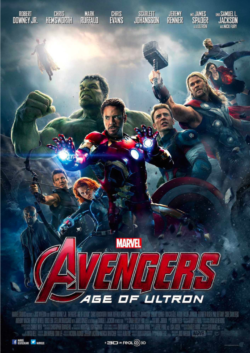
The Avengers returned in 2015’s AGE OF ULTRON, which was also written and directed by Joss Whedon. As its poster shows, the roster has expanded to include Quicksilver (Aaron Taylor-Johnson), Scarlet Witch (Elizabeth Olsen) and Vision (Paul Bettany). James Spader is great as the villain Ultron, a powerful robot who rapidly develops a murderous inclination. There is humour aplenty – for instance the team tease Captain America when he scolds Iron Man for swearing, whilst at a party the heroes each attempt (unsuccessfully) to wield Thor’s unliftable hammer.
AGE OF ULTRON also tackles real world issues, however: Quicksilver and Scarlet Witch, for example, have a vendetta against the Avengers after one of Iron Man’s bombs kills their parents. The film thereby daringly critiques the Western arms trade and even calls into question the legitimacy of foreign interventionism: Tony Stark’s Iron Legion is essentially a robotic UN peacekeeping force and, despite their insistence that “We are here to help”, they are met with hostility and even violence by the locals. In this way, the film responds to criticism that the AVENGERS series is just a glorification of US-led military alliances, here taken to an intergalactic level. In the end, of course, the film sides with the global policemen represented by the Avengers, but such self-awareness shows that the series cannot simply be dismissed as propaganda. Similar themes are also picked up in later films such as CAPTAIN AMERICA: CIVIL WAR (2016).
“[AGE OF ULTRON] daringly critiques the Western arms trade and even calls into question the legitimacy of foreign interventionism…”
AGE OF ULTRON is refreshing for other reasons, too. Instead of New York, a regular disaster film location, much of the action takes place in eastern Europe. The final battle is thrilling and suspenseful and we see real character development in Quicksilver and Scarlet Witch. Bruce Banner, aka the Hulk, meanwhile, feels guilty about all the destruction he has caused, which contrasts with the usual blasé attitude in action films to mass urban destruction.
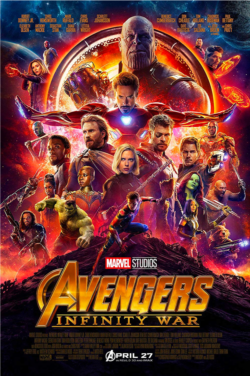
We can see that the cast depicted in the INFINITY WAR (2018) is more than double that of AGE OF ULTRON. There is also a lot more female and BAME representation: seven of the characters are played by female actors, whilst six of the twenty-three characters are played by black or Asian actors. Judging from the poster, you might expect it to be a very chaotic film, but to their credit, directors Anthony and Joe Russo succeed in creating a coherent film, despite its intergalactic cast. Although the audience should by now be familiar with most of the cast, the characters themselves sometimes get confused as to who is on whose side: The Guardians of the Galaxy, for example, initially get into a scrap with Iron Man and company to comedic effect.
“Judging from the poster, you might expect [INFINITY WAR] to be a very chaotic film, but to their credit, directors Anthony and Joe Russo succeed in creating a coherent film…”
Josh Brolin is excellent as the purple-headed villain Thanos, who is unstoppable in his quest to seize all six Infinity Stones and thereby wipe out half of all life. It’s great to see beloved characters from across the Marvel Cinematic Universe combine forces, and it all builds to a devastating climax. The inevitability of the plot does make the film somewhat predictable, however. Since the audience knows that there is another film coming, Thanos’ victory hardly comes as a shock, although this doesn’t diminish its brutality.
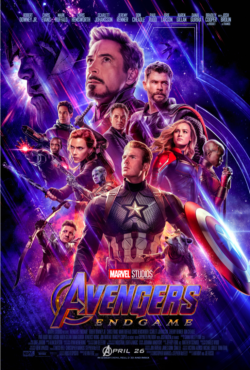
As can be seen in the poster for ENDGAME (2019), the main cast of heroes has been shrunk to just twelve: Of these, four are women (including newcomer Captain Marvel, played by Brie Larson) and two are black. The main cast from the first film, minus Nick Fury, is intact, indicating that they are still seen as the most important characters, whilst others, such as the brilliant Black Panther (Chadwick Boseman), are expendable to the main plot. Even Captain Marvel, the first Marvel superheroine to get her own film, doesn’t feature as heavily as you might expect. Indeed, when we look at all four posters, we can see that even when women and people of colour are featured, the focus remains on the white male characters, who are placed in the centre and given more space in a direct reflection of their narrative predominance.
ENDGAME is a slower, more sombre affair than the earlier films, but there is also plenty of trademark Marvel humour. The timey-wimey plot could easily have become confusing, but the Russo brothers again succeed in holding it all together, so much so that the film’s three hours whizz by.
In a time when most superhero films just boil down to who can fight the best, ENDGAME cleverly subverts this expectation: The Avengers succeed in defeating Thanos physically in the film’s first act, so they are forced to use their brains as well as their brawn to save the day. As a result, ENDGAME is packed full of surprises and beautiful moments. Although our heroes might be super, the film also emphasises their humanity, without ever being overly sentimental. The obligatory final battle, meanwhile, is stunning and, by raising the stakes (Thanos now wants to wipe out the entire universe, not just half of it), it maximises the tension.
“Although our heroes might be super, [ENDGAME] also emphasises their humanity, without ever being overly sentimental.”
ENDGAME is a thoroughly satisfying conclusion not only to the AVENGERS quartet but to the epic Infinity Saga as a whole. This is not the end, however, of the Marvel Cinematic Universe. Inevitably more superhero films will be churned out in the coming years and moviegoers the world over will eagerly pay to see them, and why shouldn’t they if they enjoy them?
The legacy of the Infinity Saga, and of the AVENGERS quartet specifically, is a mixed one: The films are often predictable, which is inevitable when they all basically follow the same format of battles, humour and pathos. These four films are undoubtedly, however, astonishing cinematic achievements – it’s tempting to even describe ENDGAME as a masterpiece of the superhero genre. The increase in BAME and female representation over the course of the franchise is laudable, although there is still a long way to go. Instead of more films about Captain America, Iron Man and Thor, let’s see more of characters like Black Panther and Black Widow.

